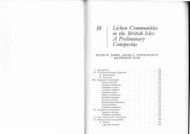You also want an ePaper? Increase the reach of your titles
YUMPU automatically turns print PDFs into web optimized ePapers that Google loves.
3* Lichen not differentiated into a basal, ±<br />
horizontal and a vertical part . 4<br />
4 Lichen beard-like pendent or shrub-like<br />
spreading or ± growing erect <strong>of</strong> thread-like and<br />
decumbent, <strong>of</strong> ± narrow, terete, angular or<br />
ribbon-like, usually branched segments,<br />
dominantly growing rather long .<br />
I: Fruticose <strong>Lichens</strong><br />
4* Thallus covering the substrate, closely appressed<br />
to loosely attached (or the margins somewhat<br />
turned up), crustose, lobed to squamulose or very<br />
indefinite, never <strong>of</strong> cylindrical or relatively<br />
thread-like segments, dominantly a flat growing<br />
form . 5<br />
5 Thallus foliose or lobed, loosely attached or<br />
appressed, yet not with the entire underside<br />
growing smoothly attached to the substrate, but<br />
attached with stalk-like attachment organs, with<br />
the typical underside <strong>of</strong>ten ± undifferentiated<br />
from the middle, both sides or only one side with<br />
a cortex II. Foliose <strong>Lichens</strong><br />
5* Thallus entirely crustose to definitely lobed at the<br />
margin, with the entire underside growing<br />
attached to the substrate or squamulose and ±<br />
free at the squamule margins or the thallus<br />
indefinite. Without typical attachment organs<br />
such as rhizines, the underside usually without a<br />
cortex, commonly consisting only <strong>of</strong> fragments or<br />
a single squamule 6<br />
6 Thallus with blue green algae (devoid <strong>of</strong> green<br />
algae), usually dark colored, gray to blackish,<br />
brown, at times gelatinous swollen; if on rock,<br />
then <strong>of</strong>ten growing on water streaks (in the keys<br />
the blue green lichens are considered fruticose<br />
and foliose lichens) III: Blue Green <strong>Lichens</strong><br />
6* Thallus with green algae (Algae green, yellow<br />
green, yellow, or orange), at times additionally<br />
with blue green algae in discrete organs. The<br />
moist thallus only very rarely swelling, then<br />
green .7<br />
7 <strong>Lichens</strong> without fruiting bodies (Includes<br />
frequently sterile species, usually with soralia or<br />
isidia . VIII: Sterile Crustose <strong>Lichens</strong><br />
7* <strong>Lichens</strong> with fruiting bodies . 8<br />
8 Fruiting bodies delicate and small, ± short<br />
needle-form (with a thin stalk and a thickened<br />
capitulum), usually -1, rarely -2 mm high or<br />
sessile to sunken, then usually covered with a<br />
dusty mass (mazaedium). Generally on rain<br />
protected sites. The indigenous species<br />
predominantly on bark and wood, if on soil, rock<br />
and mosses, than the thallus mealy and yellowish,<br />
green-yellow to whitish<br />
. IV: Coniocarpic <strong>Lichens</strong><br />
8* Fruiting bodies otherwise (if otherwise stalked,<br />
then the stalk robust, whitish to gray greenish, the<br />
capitulum brown or rose) . 9<br />
9 Fruiting bodies are perithecia and opening with a<br />
fine dot-like mouth, usually visible only under a<br />
hand lens <strong>of</strong> microscope, keg like to ± pear<br />
shaped, but generally sunken and therefore only<br />
the upper, ± convex shield is seen as rounded to<br />
oval V: Pyrenocarpic <strong>Lichens</strong><br />
9* Fruiting bodies are apothecia with ± wide<br />
openings, rarely crack-forms or openings like<br />
punctiform disks with concave, flat or convex<br />
upper sides, with or without margins 10<br />
10 Apothecia long streaks to shortly elliptical or<br />
lobed or star shaped, simple or branched .<br />
VI: Fleck or Streak Fruiting Crustose <strong>Lichens</strong><br />
10* Apothecia predominately rounded to somewhat<br />
wavy at the margins VII: Disk Fruiting<br />
Crustose <strong>Lichens</strong><br />
4 Keys for the <strong>Lichens</strong>:<br />
Genera and Sterile Species<br />
Genus Keys I: Fruticose <strong>Lichens</strong><br />
1 Thallus consisting <strong>of</strong> overlapping small foliose,<br />
squamulose or a crustose part on the substrate<br />
(basal thallus or primary thallus) and a ± erect to<br />
ascending, peg-, lance- or cup form or ± shrubby<br />
branched part (vertical thallus or podetium).<br />
Apothecium generally biatorin. . 2<br />
1* Thallus not differentiated into two types 5<br />
2 Podetia (vertical thallus) hollow, tubular, very<br />
polymorphic. Ap. usually terminal, brown, red,<br />
brown-yellow, <strong>of</strong>ten lacking. Sp. single celled.<br />
On various substrates Cladonia<br />
2* Podetia (vertical thallus) not hollow, never cup<br />
forming 3<br />
3 Podetia simple, short peg-form, always with a<br />
single terminal shield-form to spherical brown to<br />
rose colored apothecium., -7 mm high. Stalk<br />
robust, whitish to greenish in places, lacking<br />
squamules. Thallus crustose to appearing<br />
squamulose, ± coalescing, whitish to graygreenish.<br />
Sp. 1-2 celled. On soil or rock .<br />
Baeomyces<br />
3* Podetia usually branching, if simple, then<br />
generally without terminal ap . 4<br />
4 Primary thallus bright green to pale greenish,<br />
granular to mealy. Podetia very delicate, -0.3 mm<br />
thick, -10 mm high, whitish, covered with greenish<br />
granules, above all with open branches. In rainprotected,<br />
earthy rock crevices or directly on<br />
silicate rocks. Always sterile<br />
. Leprocaulon microscopicum<br />
4* Primary thallus and podetia whitish to gray,<br />
occasionally with ± blackish streaks or rose brown<br />
warts (cephalodia). Podetia sporadically with<br />
granules, squamules or covered with projecting<br />
squamules. Ap. brown to dark brown, <strong>of</strong>ten<br />
lacking. Sp. four septate 3- to multicellular. On<br />
rock and soil . Stereocaulon<br />
5 Thallus orange, yellow to green-yellow, pale<br />
greenish, or gray-greenish. 6<br />
36





